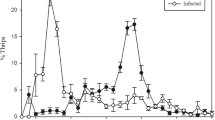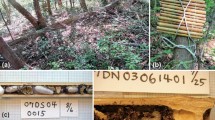Abstract
TERMINATION of diapause in the spider mite Tetranychus urticae is considered to depend solely on a period of chilling, the so-called cold rest1–3. The minimal period of chilling required to reactivate a certain percentage of the overwintering population may vary between populations of different geographic origin4. No unambiguous relationship, however, has been established between chilling period and latitude, for there may be appreciable differences in the minimal period of cold rest between strains from close localities5. The situation seemed more complex after Dubynina's6 discovery that reactivation of a Russian strain of this species increased linearly with time when mites had been induced to diapause under the influence of long days, abrupt temperature changes and severe competition for food, while reactivation was cyclical when diapause had been induced by short days and relatively low temperatures. In the latter case maximal percentages of reactivating females were obtained after diapausing mites had been kept in cold storage for 40 and 75 d. Minimal percentages were obtained after 50 and 95 d. Reactivation was complete by about the 105th day of storage. Experiments in England, however, produced no evidence for cyclical reactivation in British strains of T. urticae5. Using a Dutch strain of T. urticae, which has a constant photoperiodic reaction and has been reared in the laboratory for more than 15 yr (ref. 7), we have now found that termination of diapause in this species depends not only on a period of chilling but on photoperiod as well.
This is a preview of subscription content, access via your institution
Access options
Subscribe to this journal
Receive 51 print issues and online access
$199.00 per year
only $3.90 per issue
Buy this article
- Purchase on Springer Link
- Instant access to full article PDF
Prices may be subject to local taxes which are calculated during checkout
Similar content being viewed by others
References
Lees, A. D. Ann. appl. Biol. 40, 449–486 (1953).
Gould, H. J. & Kingham, H. G. Pl. Pathol. 14, 174–178 (1965).
Hussey, N. W. Acarologia 13, 344–350 (1972).
Bondarenko, N. V. Zool. Zh. 37, 1012–1023 (1958).
Parr, W. J. & Hussey, N. W. Hort. Res. 6, 1–21 (1966).
Dubynina, T. S. Ent. Rev. 44, 159–161 (1965).
Helle, W. Ent. exp. appl. 11, 101–113 (1968).
Author information
Authors and Affiliations
Rights and permissions
About this article
Cite this article
VEERMAN, A. Photoperiodic termination of diapause in spider mites. Nature 266, 526–527 (1977). https://doi.org/10.1038/266526b0
Received:
Accepted:
Issue Date:
DOI: https://doi.org/10.1038/266526b0
This article is cited by
-
Deoxidant-induced anoxia as a physical measure for controlling spider mites (Acari: Tetranychidae)
Experimental and Applied Acarology (2015)
-
Both the anterior and posterior eyes function as photoreceptors for photoperiodic termination of diapause in the two-spotted spider mite
Journal of Comparative Physiology A (2014)
-
An improved space-saving system for testing photoperiodic responses of insects and mites: its use for diapause experiments in the two-spotted spider mite, Tetranychus urticae (Acari: Tetranychidae)
Applied Entomology and Zoology (2011)
-
Overwintering and prevalence of Neozygites floridana (Zygomycetes: Neozygitaceae) in hibernating females of Tetranychus urticae (Acari: Tetranychidae) under cold climatic conditions in strawberries
Experimental and Applied Acarology (2008)
-
Initiation of oviposition after winter diapause in the spider mite Tetranychus urticae (Acari: Tetranychidae): prediction and historical patterns
Population Ecology (2007)
Comments
By submitting a comment you agree to abide by our Terms and Community Guidelines. If you find something abusive or that does not comply with our terms or guidelines please flag it as inappropriate.



